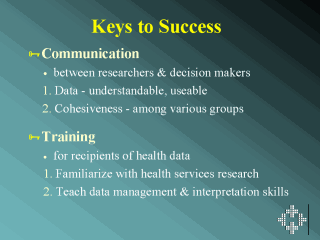| front |1 |2 |3 |4 |5 |6 |7 |8 |9 |10 |11 |12 |13 |14 |15 |16 |17 |18 |19 |20 |21 |22 |23 |review |
 |
There are two
keys to successful dissemination and implementation of research findings: 1. Communication - This must be on-going. Researchers must first convert raw health data into data that are both understandable and useable by health decision-makers and service providers. - Senior-level regional personnel require data that are standardized, comparative, and longitudinal. - Communication is also necessary to establish cohesiveness and provide for the exchange of ideas and concerns, including feedback regarding the usefulness of the data and suggestions for future work. 2. Training - To make the most effective use of the data, health planners benefit greatly from basic training in epidemiology and in managing and interpreting data. Researchers can provide such training. - Teaching these skills facilitates consistency in both processes and ensure that the data can be used appropriately in making decisions. Suggestions for providing data and training data recipients will each be discussed in turn. |